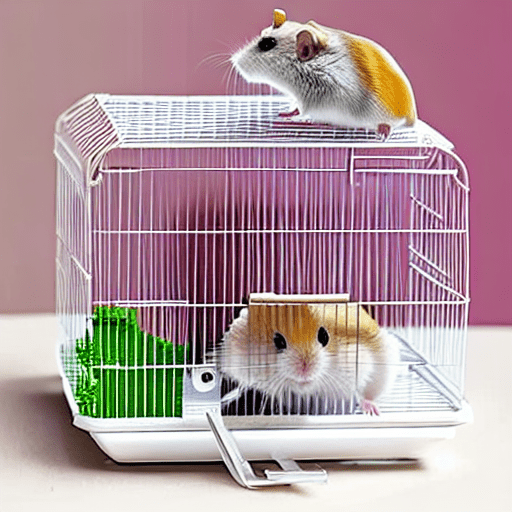To catch a hamster, use a box trap or gently scoop it up when it is calm and relaxed. Hamsters are adorable and popular pets, but sometimes they can give their owners a run for their money when it comes to catching them.
Whether your hamster has managed to escape its cage or is simply evading your attempts to handle it, knowing how to catch a hamster effectively is essential. We will explore various methods and techniques that can help you safely and successfully capture your elusive little friend.
From setting up box traps to using a calm and steady approach, we will provide you with the information you need to bring your hamster back into your care. So, let’s dive into the world of hamster catching methods and make sure our furry companions are always within our loving reach.
Understanding A Hamster’s Behavior
Hamsters have natural instincts that affect their willingness to be caught. These instincts include their small size and quick movements, which can make them feel vulnerable to predators. Additionally, hamsters are solitary animals in the wild, and being caught can be seen as a threat to their territory.
Factors such as the hamster’s age, temperament, and previous experiences also play a role in their willingness to be caught. Younger hamsters may be more energetic and harder to catch, while older hamsters may be more relaxed and easier to handle. A hamster’s past interactions with humans can also impact their behavior, as negative experiences may make them more fearful and less likely to trust people.
When trying to catch a hamster, it’s important to pay attention to their body language. A calm hamster will have relaxed posture, with their ears forward and their fur smooth. On the other hand, an agitated hamster may exhibit signs of distress, such as raised fur, pinned-back ears, and rapid movements.
By understanding a hamster’s behavior and taking note of their body language indicators, you can increase your chances of successfully catching and handling your furry friend.
Creating The Ideal Capture Environment
Creating the ideal capture environment is essential for successfully catching a hamster. Setting up a secure and comfortable hamster habitat is the first step. Ensure that the cage or enclosure is secure and escape-proof, with no openings that the hamster can squeeze through. Provide plenty of bedding material and hiding spots to make the hamster feel safe.
Lighting and temperature are also important factors to consider. Hamsters are sensitive to bright lights, so use soft, ambient lighting in the room where the cage is located. Avoid direct sunlight and harsh lighting that can cause stress. Maintaining a consistent temperature between 65-75°F (18-24°C) is ideal for hamsters, as they are sensitive to extreme temperatures.
Properly positioning the capture tools and equipment is crucial. Place a suitable hamster trap, such as a live animal trap or a DIY bin trap, in an area where the hamster is likely to roam. Use enticing bait, such as a favorite treat or a small amount of food, to lure the hamster into the trap. Make sure the trap is stable and won’t accidentally injure the hamster when triggered.
Essential Tools For Hamster Capture
When trying to catch a hamster, it is essential to have the right tools to ensure a successful capture.
One important aspect is choosing the right type of hamster trap or cage. There are various options available such as live traps, snap traps, and catch-and-release cages. Each has its own advantages and considerations, so it is crucial to carefully assess the situation and select the most appropriate option.
Another factor to consider is bait and lures. Hamsters have specific preferences, so using enticing treats such as fresh fruits, seeds, or nuts can increase the chances of attracting them towards the trap.
Lastly, it is important to use protective gloves and handling equipment. Hamsters can be agile and may try to escape or bite when cornered, so having the right protective gear, like gloves and a grip-enhancing tool, can help to safely secure the hamster once it has been caught.
Techniques For Catching A Hamster
Techniques for catching a hamster involve patience and observation in tracking the hamster’s movements. To catch a hamster, it is important to study their behavior and habits. Pay close attention to their daily routine and the areas where they spend the most time.
Creating a trap that appeals to the hamster’s natural instincts can be an effective method. Set up a secure and comfortable space with bedding, food, and water, placing a box or cage with an open entrance nearby. This will encourage the hamster to investigate and enter the trap.
Implementing safe and effective hand-catching methods is also crucial. Make sure your hands are clean and approach the hamster slowly and gently. Use a cup or scoop to carefully lift the hamster, supporting its body to avoid injuries.
Remember, catching a hamster may require time and patience. By understanding their behavior, creating a suitable trap, and implementing safe handling techniques, you can increase your chances of successfully catching a hamster.
Establishing Trust With Your Hamster
Build a bond of trust with your hamster by learning the best method for catching them. Gain their confidence with patience and gentle handling to establish a strong connection.
Building a positive relationship with your hamster requires regular interaction and patience. Treats and rewards are essential in gaining their trust. Start by offering them small treats from your hand to associate you with something positive. Gradually, your hamster will become comfortable approaching you.
Additionally, implementing gentle handling techniques is crucial for stress-free capture. Make sure you create a calm and quiet environment before approaching your hamster. Slowly place your hand inside the cage and allow them to sniff and explore at their own pace. Avoid sudden movements or grabbing the hamster forcibly, as this will only increase their fear and distrust.
Remember, building trust takes time. Be patient and consistent in your interactions, always prioritizing your hamster’s comfort. With dedication and understanding, you will develop a strong bond with your hamster.
Post-capture Care And Handling
Providing a calm and secure environment for the captured hamster:
Creating a calm and secure environment is essential for the well-being of the captured hamster. Start by setting up a hamster cage that is appropriate for its size and needs. Ensure that the cage is escape-proof and has a solid bottom to prevent any injuries. Place the cage in a quiet area of your home, away from direct sunlight and drafts, as hamsters are sensitive to temperature changes. Adding bedding material such as shredded paper or wood shavings can provide additional comfort.
After providing a suitable environment, carefully introduce the hamster to its new habitat. Open the cage door and allow the hamster to explore at its own pace. Avoid sudden movements or loud noises, as these can startle and stress the hamster. Offer some treats or small pieces of fresh fruit to encourage the hamster to explore. Additionally, provide hiding spots, tunnels, and chew toys to help the hamster feel secure and entertained.
Monitoring and adjusting the hamster’s diet and exercise routine:
Ensuring a balanced diet and regular exercise routine is vital for a hamster’s health. Monitor the hamster’s food and water intake, making sure to provide a suitable hamster pellet mix along with occasional fresh vegetables or fruits. Offer chew toys and hard treats to help maintain dental health. Regularly clean the hamster’s cage and exercise wheel to maintain hygiene. Keep an eye on the hamster’s weight and adjust its diet and exercise routine accordingly to prevent obesity or other health issues.
Troubleshooting Common Challenges
A hamster can be quite a slippery creature to catch, especially when it decides to be particularly elusive. In such cases, it is important to handle the situation carefully and consider any potential injuries or stress-related issues that may arise. It is advisable to remain calm and patient, avoiding any sudden movements that may startle the hamster. By creating a secure and enclosed environment, such as a small playpen or a room with no hiding places, the chances of catching the hamster can be increased. Additionally, setting up traps with enticing treats can help attract the hamster and increase the likelihood of capture. If all else fails, seeking professional help or advice from a veterinarian or animal behaviorist is crucial to ensure the safety and well-being of the hamster.
Frequently Asked Questions On How to Catch A Hamster
What Is The Best Way To Catch A Hamster?
The best way to catch a hamster is to create a secure and enclosed space, use treats or food to lure them in, and gently lift them up with both hands while supporting their body. Be patient, move slowly, and avoid sudden movements to prevent causing stress.
How Do You Lure A Hamster Out Of Hiding?
To lure a hiding hamster, place tempting treats near their hiding spot. Use a gentle and calm approach to encourage them out. Create a safe environment with cozy bedding and tunnels to make them feel secure and curious to explore.
Patience is key; avoid sudden movements or loud noises.
How Do You Catch A Hamster Fast?
To catch a hamster fast, create a small, enclosed space using boxes or a playpen. Use treats or a piece of fruit to lure the hamster into the space. Move slowly and avoid sudden movements. Once the hamster is inside, close off the space to safely catch it.
Where Would A Hamster Go If It Escaped?
If a hamster escapes, it could hide in small, dark places like under furniture or inside walls. Check these areas thoroughly when looking for a lost hamster.
Conclusion
Finally, with the right approach and a little bit of patience, catching a hamster can be a manageable task. By using the tips and tricks mentioned in this blog post, you can create an environment that makes your hamster feel safe and comfortable.
Remember to be gentle and calm during the process, ensuring the safety and well-being of your furry friend. Happy hamster catching!



One Comment